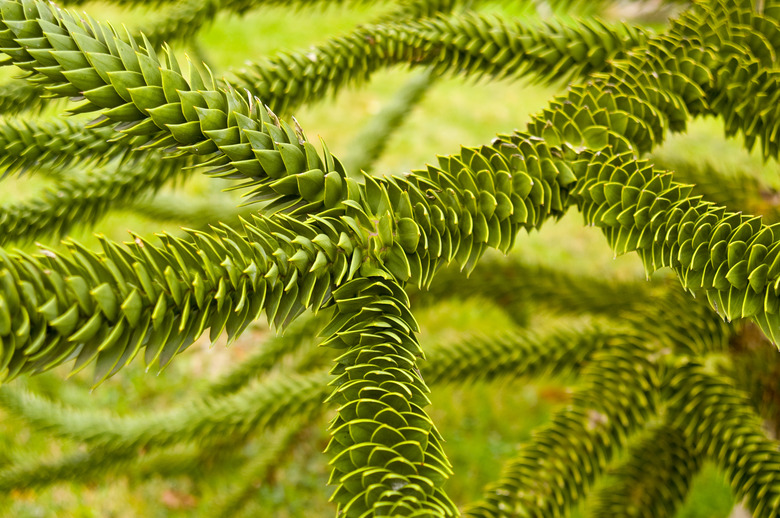How To Care For Monkey-Puzzle Trees
Monkey-puzzle trees (Araucaria araucana) are needled evergreen trees prized for their open, pyramidal form and horizontal upward-arching branches. Native to Chile and Argentina, monkey-puzzle trees thrive in humid climates with mild summers. In the United States, monkey-puzzle trees perform best in U.S.
Things Needed
- Compost
- All-purpose, water-soluble fertilizer (optional)
- Bypass pruning loppers
- Household disinfectant
Monkey-puzzle trees (Araucaria araucana) are needled evergreen trees prized for their open, pyramidal form and horizontal upward-arching branches. Native to Chile and Argentina, monkey-puzzle trees thrive in humid climates with mild summers. In the United States, monkey-puzzle trees perform best in U.S. Department of Agriculture plant hardiness zones 7 through 11. Despite their odd and showy appearance, monkey-puzzle trees require simple care.
Step 1
Plant monkey-puzzle trees in full sun locations that receive six or more hours of direct sunlight per day to help ensure healthy growth and development. In their native habitat, monkey-puzzle trees can be grown successfully in partial sun locations that receive as little as four hours of direct sunlight daily. In the United States, a partial sun location is unlikely to provide the light your trees need to grow and thrive.
- Monkey-puzzle trees (Araucaria araucana) are needled evergreen trees prized for their open, pyramidal form and horizontal upward-arching branches.
- In their native habitat, monkey-puzzle trees can be grown successfully in partial sun locations that receive as little as four hours of direct sunlight daily.
Step 2
Water monkey-puzzle trees weekly whenever rainfall fails to provide them with at least 1 inch of moisture per week. Reduce the frequency of watering during the cooler fall and winter months. Provide just 1 inch of supplemental irrigation every two weeks, or as often as necessary to keep the soil moist, but well drained.
Step 3
Fertilize monkey-puzzle trees at planting time by incorporating compost into your soil. In addition, if your soil is poor, fertilize monthly from early spring through summer with a half-strength solution of an all-purpose, water-soluble fertilizer. For example, mix 1/2 tablespoon of a 15-15-15 fertilizer or similar product with 1 gallon water. Avoid overfertilization, which may damage the roots of your trees.
- Water monkey-puzzle trees weekly whenever rainfall fails to provide them with at least 1 inch of moisture per week.
- In addition, if your soil is poor, fertilize monthly from early spring through summer with a half-strength solution of an all-purpose, water-soluble fertilizer.
Step 4
Check monkey-puzzle trees for diseased, winter-damaged or dead branches each year in the very early spring. Remove problem branches promptly as they can cause the health of your trees to deteriorate. Prune the branches with sharp, bypass pruning loppers. Sterilize your lopper blades with household disinfectant before and after you prune, to prevent the spread of disease. When cared for well, monkey-puzzle trees have few serious insect pests or disease problems.
Tip
If growing small monkey-puzzle trees indoors in cooler climates, mist the foliage of your trees regularly. Monkey-puzzle trees perform best in humid climates.
Warning
Monkey-puzzle trees drop branchlets and sharp, pointy leaves year-round. Wear gardening gloves when cleaning up monkey-puzzle tree debris to avoid injury.
